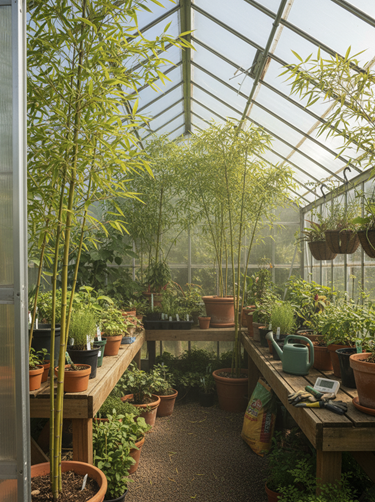
Surprisingly, scientists classify bamboo among grasses. Among the thousands of varieties, there are hardwood and softwoods. It is the tallest grass in the world and some hardwood varieties are so hard, they are used as wood.
The Bambuseae are the most diverse tribe of bamboos in the grass family. It consists of woody species from tropical regions, including some giant bamboos. Their sister group are the small herbaceous bamboos from the tropics in tribe Olyreae, while the temperate woody bamboos are more distantly related.
With that said, Americans most often grow Bamboo as a houseplant. It is easy to grow, requires little attention, and thrives in almost any light. When grown indoors as houseplants, bamboo is planted in containers filled with decorative stones. Just add water and you have a beautiful, green houseplant. You can also grow it indoors in soil. Plants grown in soil will grow faster and larger, than plants grown in water.
Plant Propagation
Bamboo plants can be grown from cuttings. Select healthy, vigorous, young canes and root them in water. Bamboo is also propagated from Rhizomes. Plant the rhizomes in large containers at a depth of 1 to 2 inches deep. The basic varieties are categorized as clumping or running which describes the plant growth habit. Clumping varieties are best for indoors houseplants and greenhouses.
Care and Maintenance
Bamboo Grown in Water
Place rooted canes in a container filled with decorative stones and fill the container with water. The water should be replaced routinely. Place the plant in full, partial, or filtered light. The plant will grow very slowly and fertilizers are not needed. However, adding a little diluted liquid fertilizer from time to time will cause the plant to grow a little faster. This plant does not need a lot of light, and will grow better in partial shade, making it an ideal greenhouse or houseplant.
Bamboo Grown Indoors in Soil
Clumping varieties work best. Select a large container with holes in the bottom for drainage. Bamboo grows best in loose, rich soil so use plenty of peat moss and other loose soil medium. Fill the container partially with soil and plant the rhizomes an inch or two deep. For transplanting small plants into containers, plant them about level with the depth the roots currently are at. Water thoroughly, and keep soil moist and continue to water when the soil begins to dry out. When growing in soil, apply a general purpose fertilizer, or one high in nitrogen on an occasional basis.
Fun Facts About Bamboo
- Bamboo is a lucky symbol, bringing you good fortune. It is most notably a symbol to be lucky in love.
- Several Asian cultures, including that of the Andaman Islands, believe humanity emerged from a bamboo stem.
- Native to China, Bamboo is the favorite food of Giant Panda Bears.
- The size of bamboo depends on the species. Largest species of bamboo can reach 1300 feet in height.
- Bamboo can grow either as woody, tall plant or as shorter, herbaceous plant.
- Individual stems of bamboo are called culms. They arise from the underground rhizome and emerge from the ground fully developed.
- Flowers of bamboo are rarely seen. Some species develop flowers after 65 or even 120 years.
- All plants of one bamboo species develop flowers at the same time, no matter where they are located in the world.
- Besides from rhizome, bamboo can develop from the seeds arranged in the clusters at the end of the branches.
- Young shoots contain toxin called taxiphyllin. Because of this, bamboo needs to be cooked (high temperature destroys toxin) before consumption.
- Various animals on the planet use bamboo in their diet. Panda’s diets is based on bamboo exclusively, while mountain gorilla and lemurs of the Madagascar eat it to enrich their regular diet.
- Bamboo is used in folk medicine to treat infections and to accelerate healing of wounds.
- Bamboo has a stronger structure than steel and is widely used in the construction industry.
- It is used in the manufacture of floors, furniture, house walls, skateboards, bicycle frames and helmets.
- Bamboo can survive more than 120 years in the wild.




Comment here